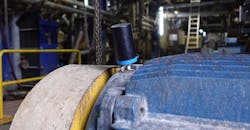The many facets of PdM: Tire manufacturer upgrades vibration program to continuous monitoring
The medley of predictive maintenance (PdM) strategies for improving machine health is growing larger and more powerful, whether using classic portable tools for non-critical asset inspection rounds and on-site problem verification and troubleshooting, or advanced technologies such as the IIoT, cloud, and AI and ML algorithms.
Leaders and analysts who go on record by documenting improvements gained from predictive maintenance initiatives provide a window into the immense potential of today’s enabling technologies. This article is one of seven diverse case studies that illustrate some of the many PdM methods and applications employed today.
The other case studies include:
- Analyst foresees AI/ML driving widespread adoption of prescriptive maintenance
- Oil and gas supermajor uses AI predictive analytics
- Midstream energy company uses IIoT strategy with integrated CMMS
- Consumer products manufacturer uses AI and ML models
- Self-driving truck company uses CMMS, BI tooling, and mobile app
- Thermal battery manufacturer uses Generative AI-driven data operations platform
- Mining company uses industrial edge data platform and SCADA system
Challenge: Bi-monthly vibration measurements on a tire manufacturer’s production line were routinely performed, but between these predictive measurements, disturbing sounds and visible vibration were noticed on a critical machine following a modernization of the production line. Continuous monitoring of the machine was needed to facilitate troubleshooting and predictive maintenance.
Solution: Wi-care, a wireless system for monitoring machine conditions 24/7 from I-care Reliability, was installed on the machine. Five sensors collected and transmitted real-time vibration measurement data to I-care's "I-see" cloud-based analytical platform, which alerted plant reliability personnel about anomalous and critical values. For several days in a row, the amplitudes increased, and so did the risk of a breakdown or accident. But then the values stabilized, allowing production to continue until a planned outage.
Results: The tire plant avoided the significant repair costs and production losses associated with unplanned line stoppages due to Wi-care allowing precise prediction of failure. I-care engineers identified a corrective action that was successfully implemented by plant mechanics during scheduled downtime.
About the Author

Sheila Kennedy
CMRP
Sheila Kennedy, CMRP, is a professional freelance writer specializing in industrial and technical topics. She established Additive Communications in 2003 to serve software, technology, and service providers in industries such as manufacturing and utilities, and became a contributing editor and Technology Toolbox columnist for Plant Services in 2004. Prior to Additive Communications, she had 11 years of experience implementing industrial information systems. Kennedy earned her B.S. at Purdue University and her MBA at the University of Phoenix. She can be reached at [email protected] or www.linkedin.com/in/kennedysheila.

